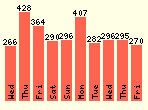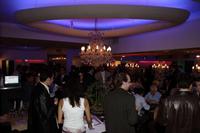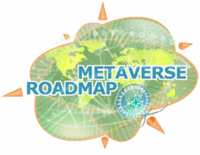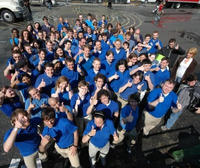|
This is my dynamic, frequently updated homepage. This is a NewsLog, also known as a WebLog or Blog.
Everything is evolving, so don't assume too much.
People to watch:
Adina Levin
Andrius Kulikauskas
Britt Blaser
Catherine Austin Fitts
Chris Corrigan
Clay Shirky
Dan Gillmor
Dave Pollard
David Allen
David Weinberger
Dewayne Mikkelson
Dina Mehta
Doc Searls
Elisabet Sahtouris
Elizabeth Lawley
Euan Semple
Florian Brody
Frank Patrick
Gen Kenai
George Dafermos
George Por
Graham Hancock
Greg Elin
Hazel Henderson
Heiner Benking
Inspector Lohman
Jean Houston
Jerry Michalski
Jim McGee
Jim Moore
John Abbe
John Perry Barlow
John Robb
Joi Ito
Jon Husband
Jon Lebkowsky
Jon Udell
Jonathan Peterson
Judith Meskill
Julian Elvé
Julie Solheim
Kevin Marks
Lawrence Lessig
Leif Smith
Letecia Layson
Lilia Efimova
Lisa Rein
Marc Canter
Mark Oeltjenbruns
Mark Pilgrim
Mark Woods
Martin Dugage
Martin Roell
Mary Forest
Matt Mower
Max Sandor
Michael Fagan
Mike Owens
Mikel Maron
Mitch Kapor
Mitch Ratcliffe
Nathalie dArbeloff
Netron
Noam Chomsky
Paul Hughes
Peter Kaminski
Phil Wolff
Philippe Beaudoin
Ray Ozzie
Raymond Powers
Rebecca Blood
Roger Eaton
Roland Tanglao
Ross Mayfield
Scott Lemon
Sebastian Fiedler
Sebastien Paquet
Skip Lancaster
Spike Hall
Steven Johnson
Stuart Henshall
Thomas Burg
Thomas Madsen-Mygdal
Thomas Nicholls
Timothy Wilken
Todd Suomela
Tom Atlee
Tom Munnecke
Tom Tomorrow
Ton Zijlstra
Lionel Bruel
Loic Le Meur
Nancy White
Mark Frazier
Merlin Silk
Robert Paterson
Colby Stuart
Nova Spivack
Dan Brickley
Ariane Kiss
Vanessa Miemis
Bernd Nurnberger
Sites to watch:
FutureHi
Co-intelligence Institute
Global Ideas Bank
Collective Intelligence
YES Magazine
Electronic Frontier Foundation
Free Expression Network
Greater Democracy
Independent Media
Disinfopedia
Disinformation
Friendly Favors
Action without borders
Manufacturing Dissent
Explorers Foundation
Imaginify
WorldChanging
Smart Mobs
ThoughtsOnThinking
Disclosure Project
Forbidden Science
Nanodot
Edge
HeadMap
BoingBoing
MetaFilter
Absara
Rhizome
Escape Velocity
Webcamorama
Do No Harm
Junto
NotThisBody
Openworld
Space Collective
Emergent by Design
Collective Web
French:
Emmanuelle
Manur
Elanceur
Loeil de Mouche
IokanaaN
Blog d'Or
Le Petit Calepin
GeeBlog
Absara
Guillaume Beuvelot
Ming Chau
Serge Levan
Jean Michel Billaut
C'est pas Mécanique

I live in Toulouse, France where the time now is:
01:50
Unique Readers:

Primarily
Public Domain
Everything I've written here is dedicated to the
Public Domain.

The quotes from other people's writings, and the pictures used might or might not be copyrighted, but are considered fair use. Thus, overall, this weblog could best be described as being:
Primarily Public Domain. |
Syndication:
 ![Validate my RSS feed [Valid RSS]](http://www.newciv.org/pic/valid-rss.png)
|
| Tuesday, May 30, 2006 |  |
|
|
|
 CNN: CNN:It's a question that has baffled scientists, academics and pub bores through the ages: What came first, the chicken or the egg?
Now a team made up of a geneticist, philosopher and chicken farmer claim to have found an answer. It was the egg.
Put simply, the reason is down to the fact that genetic material does not change during an animal's life.
Therefore the first bird that evolved into what we would call a chicken, probably in prehistoric times, must have first existed as an embryo inside an egg. I'm so glad we got that sorted out. Did they get paid for figuring this out? So, where did that first egg come from? It is a non-sensical and misleading question, as the chicken and the egg are part of the same system. Even without that, their logic is flawed. It is a lot more likely that some animal by some evolutionary accident will depose some of its genetic material somewhere in such a way that it can grow into a new animal than it is that a fully programmed egg somehow happened. Eggs don't do very much on their own. Anyway, I'm already confusing myself, so I should probably have stayed with the thought that it isn't a valid question.
[ Knowledge | 2006-05-30 23:42 | | PermaLink ] More >
|
|
| Sunday, May 28, 2006 |  |
|
|
|
 Oh, I need to write something about the event I was co-organizer of last week. It is called Creme de Violette. It is Lionel's idea. Speed Consulting. It is like Speed Dating, just different. The basic idea is that one invites some experts/consultants and some business people, and then one has rounds where the participants can go and talk with the experts and ask them questions, and have a little free consulting session in 11 minutes, until the gong sounds and the next round starts. Oh, I need to write something about the event I was co-organizer of last week. It is called Creme de Violette. It is Lionel's idea. Speed Consulting. It is like Speed Dating, just different. The basic idea is that one invites some experts/consultants and some business people, and then one has rounds where the participants can go and talk with the experts and ask them questions, and have a little free consulting session in 11 minutes, until the gong sounds and the next round starts.
In France this has been done in Paris, but apparently nowhere else. So, the idea here is to do it in a more relaxed southern way, with good food and wine in a restaurant. And, well, this is the third time we did this. The first two times I was one of the experts, which was quite fun, and even got me an interesting project and a part of a little upstart company.
This time we had more partners participating, and added some new elements, which actually made it a good deal more interesting. The basic idea was to add elements that are "speed" oriented, or that makes something happen in real-time during the evening, and which facilitate the networking. It didn't all work, but it didn't matter too much, as what worked worked well. But I had for example made a database meant to keep profiles of all participants, so that everybody would have a little bio and picture, and maybe a statement of what they offer, or what they're looking for, and that would be available during the evening, and/or before and after, as possible. Which makes it a good deal easier to do networking, as you're able to know who everybody is. I've done similar things at events before, with very good results.
The MC was a well-known talkshow host and public speaker, Yann Fernandez. There was a journalist interviewing participants. A professional photographer taking pictures of everybody. Somebody taking video. Several people who's job it was to help people find each other. Several hostesses.
One thing that worked really well was the production of a newsletter during the evening. In one corner was a little production team with computers. A video projector showed what they were working on at the time. They would get photos from the photographer, the journalist would submit articles, and they would lay it out. All during the evening. You can see the result as a PDF. The idea was that at the end of the evening, everybody would leave with a copy of it. But that depended on a few other technical details that didn't work. Like the WiFi internet connection. And therefore the internet sharing application we had planned, based on a clever invention from a local startup company, Personalité Numerique, which basically turns any USB key into a large virtual disk, from which one transparently can share data with others.
Anyway, overall it was a success, and we'll be sure to develop some of these ideas further. Which incidentally have created a bit of interest from various organizations that are interested in having more effective networking events.
[ Diary | 2006-05-28 22:59 | | PermaLink ] More >
|
|
|
|
Article here about some people studying e-mail communication, and how it can go wrong.Though e-mail is a powerful and convenient medium, researchers have identified three major problems. First and foremost, e-mail lacks cues like facial expression and tone of voice. That makes it difficult for recipients to decode meaning well. Second, the prospect of instantaneous communication creates an urgency that pressures e-mailers to think and write quickly, which can lead to carelessness. Finally, the inability to develop personal rapport over e-mail makes relationships fragile in the face of conflict.
In effect, e-mail cannot adequately convey emotion. A recent study by Profs. Justin Kruger of New York University and Nicholas Epley of the University of Chicago focused on how well sarcasm is detected in electronic messages. Their conclusion: Not only do e-mail senders overestimate their ability to communicate feelings, but e-mail recipients also overestimate their ability to correctly decode those feelings.
One reason for this, the business-school professors say, is that people are egocentric. They assume others experience stimuli the same way they do. Also, e-mail lacks body language, tone of voice, and other cues - making it difficult to interpret emotion.
"A typical e-mail has this feature of seeming like face-to-face communication," Professor Epley says. "It's informal and it's rapid, so you assume you're getting the same paralinguistic cues you get from spoken communication."
To avoid miscommunication, e-mailers need to look at what they write from the recipient's perspective, Epley says. One strategy: Read it aloud in the opposite way you intend, whether serious or sarcastic. If it makes sense either way, revise. Or, don't rely so heavily on e-mail. Because e-mails can be ambiguous, "criticism, subtle intentions, emotions are better carried over the phone," he says.
[ Information | 2006-05-28 23:21 | | PermaLink ] More >
|
|
| Wednesday, May 17, 2006 |  |
|
|
|
This is the idea. One makes a list of 101 things to do over 1001 days. Things to do that are realistic, but also stretching. I.e. something you want to do, or that would be fun to do, but which you wouldn't necessarily get around to doing otherwise. Carving an ice sculpture, skinny dipping in the Carribean, put money in random parking meters that have run out, stay up all night and finish a book, ride the metro from one end to the other. And you'll have 1001 days to finish the list, which is about 2.75 years, which is plenty of time, so one doesn't have to be stressed about it. And it might be small or big things. One chooses oneself.
Apparently a lot of people are doing this, and I think it is a cool idea. Putting on your to-do list to do senseless life-affirming things that make you feel good, and which stretch your boundaries a bit. You can find a list of people's lists in the sidebar of that page. There are people who build their blog around the progress with their list. Like 101 Things to Do.
Hm, personally I'm a bit ambivalent on making a list like that public. Not that I generally mind sharing my thoughts with the whole world, but somehow I find to-do lists more intimate. Mine would probably be more politically incorrect than my normal blog writing. But it is inspiring to see what other people want to do.
[ Inspiration | 2006-05-17 18:01 | | PermaLink ] More >
|
|
| Tuesday, May 9, 2006 |  |
|
|
|
 10 years ago it looked to me like the net ought to be going 3D within a couple of years. You know, Cyberspace, where you could fly around in landscapes of data somehow, or virtual realities. But nothing much really happened, other than that the virtual worlds that are there have added more features. But now some people are calling the vision for the 3D web "The Metaverse" and my friends at the Accelerating Studies Foundation have organized a Metaverse Roadmap Summit. Article from cNet here. 10 years ago it looked to me like the net ought to be going 3D within a couple of years. You know, Cyberspace, where you could fly around in landscapes of data somehow, or virtual realities. But nothing much really happened, other than that the virtual worlds that are there have added more features. But now some people are calling the vision for the 3D web "The Metaverse" and my friends at the Accelerating Studies Foundation have organized a Metaverse Roadmap Summit. Article from cNet here.PALO ALTO, Calif.--With the spread of online games, virtual worlds and services like Google Earth and MySpace.com, people may soon be spending more time, communicating more and shopping more in complex 3D Web environments.
That's why several dozen of the most influential figures in video game design, geospatial engineering, high-tech research, software development, social networking, telecommunications and other fields gathered here Friday and Saturday for the first Metaverse Roadmap Summit.
The proliferation of social networking sites, online games and virtual worlds may lead to complex 3D Web environments.
Bottom line:
The notion of the so-called metaverse attracted dozens influential tech figures to conceive a path to an Internet dominated by 3D technology, social spaces and economies.
The event, held at the SRI International and produced by the Acceleration Studies Foundation (ASF), was the initial step toward what organizers and attendees alike hope will be a coherent path to the so-called metaverse--an Internet dominated by 3D technology, social spaces and economies.
As such, the invite-only group spent the two days in a series of talks, small breakout discussions and group presentations--all in the pursuit of consensus about what the metaverse, or some would say 3D Web, will look like in 10 years.
In the end, organizers will sift through hours of recordings of the various discussions and plan to produce a public document by the end of the summer that will lay out what they believe were the overriding conclusions and directions of the event. First, though, attendees will pore over two drafts of the document in the coming months to weigh in on the organizers' take on the so-called road map.
Ultimately, the ASF hopes to produce regular small Metaverse Roadmap gatherings, as well as full summits at least every two years.
In the meantime, the organizers have their work cut out for them because agreement about the metaverse of 2016 was hard to find. Hey, I want it, so you've better agree on something. For that matter, I want more than three dimensions. That's already too little in the real world. So whereas the 2D desktop metaphor we've been stuck with in computers is certainly inadequate, it isn't necessarily terribly much better if it gets expanded to be 3D cities with buildings and rooms with stuff in them. I'd like at least 5D please.
[ Knowledge | 2006-05-09 23:12 | | PermaLink ] More >
|
|
|
|
A micropayment system for blogs, indieKarmaSupport your favorite independent blogs & websites - give a penny for their thoughts
How does this work? Easy. Join the indieKarma network and add one dollar to your account (for the first 5000 accounts, this dollar is free).
Each time you visit a website or blog on the indieKarma network, your account is seamlessly debited just one cent. It's the smallest of micro-payments, directly supporting the blog or website you're enjoying.
At the bottom of each page on any blog or website on the indieKarma network, you'll see a small "dock", with a message from the site. If you're browser is logged in, this will thank you for your support and quickly fade out for the rest of your visit. If your browser is not logged in, it will encourage your support at each page reload.
One cent may be an inconsequential sum to you, but it can make a world of difference to content creators running the independent blogs and websites you enjoy. A fine idea. So, if I have 1500 visitors per day, that would net me $15, I suppose. If they all were members of indieKarma, which is a huge IF, of course. Here's what Jason Kottke says about it. Mostly very positive, but some concerns about the pop-up thing at the bottom being too intrusive, and whether it will gain critical mass. Anyway, I'm gonna give it a shot, since I think it is a basically good idea.
[ Information | 2006-05-09 23:41 | | PermaLink ] More >
|
|
| Sunday, May 7, 2006 |  |
|
|
|
 Improv Everywhere is a sort of flashmob group, of people who create surrealistic happenings, just for the fun of it, and to see what would happen. Here they had 50 people show up at the same time in a Best Buy store, dressed like Best Buy employees. Which greatly freaked out the management, even though they weren't doing anything else than standing around looking helpful, answering people's questions. Improv Everywhere is a sort of flashmob group, of people who create surrealistic happenings, just for the fun of it, and to see what would happen. Here they had 50 people show up at the same time in a Best Buy store, dressed like Best Buy employees. Which greatly freaked out the management, even though they weren't doing anything else than standing around looking helpful, answering people's questions. One employee passed me with a smile on his face and exclaimed, "All you guys have GOT to get together for a photo, because no one is ever going to believe this!" Another came up to me and said, "Let me guess, you're waiting on your friend? Good answer." I guess at that point he had heard that answer more than a few times.
The reaction from the employees was pretty typical as far as our missions go. The lower level employees laughed and got a kick out of it while the managers and security guards freaked out. Some employees speculated that we were a cult, or maybe protesters. One employee tried to get a date out of the incident, informing one agent, "Tell that girl in the computer section that 'Mike says hi.'" Another employee after being told to go get some merchandise from the back, declared, "You should ask one of these other 50 people to do it!"
Security guards and managers started talking to each other frantically on their walkie-talkies and headsets. "Thomas Crown Affair! Thomas Crown Affair!," one employee shouted. They were worried that were using our fake uniforms to stage some type of elaborate heist. "I want every available employee out on the floor RIGHT NOW!" Ah, it is always good to cause a scene and stir things up a bit, if it is well intended.
[ Culture | 2006-05-07 22:32 | | PermaLink ] More >
|
|
|
|
 This is a PDF file, a paper from some investment strategy company on ... the psychology of happiness. I suppose it is meant to show investors that there's more to life than money, and maybe that more is important. As Adam Smith said: This is a PDF file, a paper from some investment strategy company on ... the psychology of happiness. I suppose it is meant to show investors that there's more to life than money, and maybe that more is important. As Adam Smith said: Through the whole of his life he pursues the idea of a certain artificial and elegant repose which he may never arrive at, for which he sacrifices a real tranquillity that is at all times in his power, and which, if in the extremity of old age he should at last attain to it, he will find to be in no respect preferable to that humble security and contentment which he had abandoned for it. It is then, in the last dregs of life, his body wasted with toil and disease, his mind galled and ruffled by the memory of a thousand injuries and disappointments which he imagines he has met with from the injustice of his enemies, or from the perfidy and ingratitude of his friends, that he begins at last to find that wealth and greatness are mere trinkets of frivolous utility, no more adapted for procuring ease of body or tranquillity of mind, than the tweezer-cases of the lover of toys. So, they present some various studies and graphs of how happy people are, and what seems to be contributing to it. It adds up pretty much to this set of bullet points: 1) Don’t equate happiness with money. People adapt to income shifts relatively quickly, the long lasting benefits are essentially zero.
2) Exercise regularly. Regular exercise is an effective cure for mild depression and anxiety. It also stimulates more energy, and is good for the mind and body.
3) Have sex (preferably with someone you love). Need I say more?
4) Devote time and effort to close relationships. Confiding and discussing problems and issues is good for happiness, so work on these relationships.
5) Pause for reflection, meditate on the good things in life. Focusing on the good aspects of life helps to prevent hedonic adaptation.
6) Seek work that engages your skills, look to enjoy your job. Doing well at work creates happiness, and the easiest way of doing well at work, is doing a job you enjoy.
7) Give your body the sleep it needs. Too many people have a sleep deficit, resulting in fatigue, gloomy moods and lack of concentration.
8) Don’t pursue happiness for its own sake, enjoy the moment. Because people don’t understand what makes them happy, pursuing happiness can be self-defeating. Additionally, if people start to aim for happiness they are doing activities for happiness’s sake rather than actually enjoying the activity itself.
9) Take control of your life, set yourself achievable goals. People are happiest when they achieve their aims, so set yourself goals which stretch you, but are achievable.
10) Remember to follow rules 1-9. Following these guidelines sounds easy, but actually requires willpower and effort.
[ Inspiration | 2006-05-07 23:21 | | PermaLink ] More >
|
|
| Wednesday, April 12, 2006 |  |
|
|
|
What's a fib? It is a 20 syllable poem written in the 1/1/2/3/5/8 Fibonacci sequence. Lots of stuff in nature follows this sequence. Mathematically it is formed by adding the previous two numbers together to make the next one. So, 0+1=1, 1+1=2, 1+2=3, 2+3=5, etc. So, brilliant idea, you can make a poem like that, similar to a haiku. I.e. 1 syllable in the first line and second line, then two syllables, up to 8 in the last line. More examples here. OK, I'll have to try this. I suck at counting syllables, but let me give it a shot...One
Two
Two words
I can count
Syllables are fun
Fibonacci now here I come Hm, not very poetic.New
Day
Get up
Coffee cup
Paper, hat and door
An office bee can't ask for more Argh, now I seem to be rhyming too, and about boring people.Life
Blood
Deep Red
Take a breath
Fire in the belly
Ready for a day in the sun OK, that's a little betterI
Can
See you
So clearly
Why are you out there?
Darkness blew away with a puff Hm, strange. I'm not sure I'll be a Fibonarian, but it is a good exercise.
If you're unsure about counting syllables, this is a page that will calculate it.
[ Inspiration | 2006-04-12 00:30 | | PermaLink ] More >
|
|
|
|
 My new iMac is in the mail from the Apple store. So now I can allow myself to complain about my old one in the meantime. My new iMac is in the mail from the Apple store. So now I can allow myself to complain about my old one in the meantime.
The last couple of years my computer has been a 12 inch aluminum powerbook. Which is a handy little machine, very convenient for taking on the road. And if you plug in a big screen and a keyboard, in principle a perfectly fine thing to have on one's desktop.
But the last year it has just gotten increasingly unbearably slow. Whenever anybody asks me about that happening to their computer, I always deny that it is even possible. Computers don't just get slow from getting older. On Windows maybe. It might be full of spyware, or you haven't defragged your disk or something. But a Mac? There should just be no good reason for it.
Well, various reasons compound. Everything very gradually requires more and more resources, and suddenly the computer that was super-fast a couple of years ago seems like it isn't moving at all.
Like, Firefox has tabs, and I somehow can't seem to live without 30 or so different pages open in different tabs. A number of which will nowadays do some kind of Ajax and Javascript thing all the time, or there's some Flash or whatever. All of which uses memory and processing power.
And I have an editor with another 20 or 30 open documents, and ICQ and iChat and Skype, and the calendar, and TextEdit, and a few terminal windows. I think that is all quite modest. I don't even dare try to have iTunes running, let alone iPhoto, or Word, or various other things I'd have reason to use.
Of course it is running Apache and MySQL and various other things under the hood, but none of those seem to be much trouble. Mainly it is Firefox and ICQ that uses up the resources, and an annoying HP printer driver. Oh, and OSX nicely allows several people to be logged in at the same time, and we're a bit low on computers right now, so a few more things running in another desktop.
And this Powerbook only has room for 640MB or memory, which it has of course. But which nowadays is pitifully little.
When it has a lot to do, like just having Firefox open, the fan starts running, which somehow slows things down even more.
There's nothing worse, when you have a lot to do, than your computer being, like, 10 times slower than you are. You type something and it appears 5 seconds later. You click on a window and a spinning beachball hangs there for 10 seconds before anything happens.
It is like when you're used to always-on broadband internet, and suddenly you're on a dial-up modem. You suddenly become keenly aware that you maybe should have arranged things so that there wasn't such a bottleneck, but you can't do it before you're back on your normal connection, and when you are, you forget all about it. Likewise, when everything is slow, you can quickly get the idea that you maybe should have arranged things so that the computer had much less to do, but since it is slow as molasses, you give up doing anything with it other than the most basic and needed stuff.
23 years ago my IBM PC 8.77MHz, 128k, with dual 360k floppies was lightning fast. I never ran out of memory. I have 500 times as much memory here. Why, oh why must I suffer?
Well, I mainly wanted just to complain. But also remind myself, before I get spoiled again by a fast new computer, that there's plenty of opportunity for making many things more efficient.
Like, why do I have so many browser windows open? Well, there's gmail, there's a dynamic home page, there's a feed aggregator, there's several admin pages for sites I need to pay attention to every day, there's a page with graphs and monitoring information for my servers, there's a couple of blogs, a couple of member areas. That's 10 already. For the rest, if there's site with information I need to do something with, why don't I just put it into a bookmark list or into delicio.us or furl? Well, I do, but those are all more cumbersome to save to and find something in than just having it open. Windows need to pop up, stuff need to be saved, the page needs to reload, etc. Still too many steps, and I can't arrange things the way they make sense for me. So, just a reminder to myself that it is a good idea to come up with better and faster ways of organizing stuff, even if one can buy a faster computer every couple of years.
[ Diary | 2006-04-12 01:20 | | PermaLink ] More >
|
|
| Saturday, April 8, 2006 |  |
|
|
|
Yahoo. The Software Freedom Law Center will offer a non-profit umbrella for any free or open source software projects that want it."The mission of the Conservancy is to provide free and open source software developers with all of the benefits of being a tax-exempt corporate entity without having to do any of the work of setting up and maintaining such an entity," said Dan Ravicher, legal director for the Software Freedom Law Center and one of the initial directors of the Conservancy. "Letting projects pass off the mundane administrative burdens placed on those wishing to benefit from nonprofit status is a significant way to keep developers focused on what they do best -- writing software."
The Software Freedom Conservancy will be a fiscal sponsor for FOSS projects by providing free financial and administrative services to its members. It will provide individual developers protection from personal liability for their projects and will seek to provide participating projects with tax-exempt status, allowing them to receive tax deductible donations. The Conservancy will file a single tax return that covers each of the member's projects and will handle other corporate and tax related issues on behalf of its members. In addition, the Conservancy can hold project assets and manage them at the discretion of the project, which removes another fiscal burden from developers who are focused on software innovation.
[ Information | 2006-04-08 16:21 | 0 comments | PermaLink ]
|
|
|
|
"Web2.0" is one of the hot buzzwords right now. But a fuzzy term that a lot of people seem to dislike, because, well, it is a buzzword, and there's not wide agreement on what exactly it is, or whether it really is something new. But largely it has something to do with a new breed of websites that have more sophisticated user interfaces, particularly ones that use Ajax to update stuff on the page without having to reload it. And it has something to do with engaging large numbers of people in contributing content and in adding value to existing content. And it has something to do with web services, like RSS feeds. I.e. standardized ways one can access stuff, no matter where it comes from. And thus that new possibilities open for creating "mashups", i.e. new combinations of data from various sources. For example, Flickr is a photo sharing site, and it makes it easy for you to show those pictures in all sorts of settings other than their own site. GoogleMaps allow you to create maps based on their data, putting your own stuff on the maps.
Dion Hinchcliffe is one of the most articulate proponents for Web2.0, providing ongoing updates on his blog on where it is at. Like, see his recent State of the Web2.0. From there, a little overview of what it IS:For those who don't follow it all the time, it might even be hard to remember what all the pieces of Web 2.0 are (and keep in mind, these elements are often reinforcing, so Web 2.0 is definitely not a random grab bag of concepts). Even compact definitions are sometimes a little hard to stomach or conceptualize But the one I like the best so far is Michael Platt's recent interpretation just before SPARK. Keep in mind, the shortest definition that works for me is that "Web 2.0 is made of people." However, it's so short that important details are missing and so here's a paraphrase of Platt's summary.
Key Aspects of Web 2.0:
- The Web and all its connected devices as one global platform of reusable services and data
- Data consumption and remixing from all sources, particularly user generated data
- Continuous and seamless update of software and data, often very rapidly
- Rich and interactive user interfaces
- Architecture of participation that encourages user contribution
I also wrote a review of the year's best Web 2.0 explanations a while back and it goes into these elements in more detail if you want it. But there's a lot more to Web 2.0 than these high level elements would indicate. A key aspect not mentioned here, though I cover it in Sixteen Ways to Think in Web 2.0, is the importance of user ownership of data. The centrality of the user as both a source of mass attention (over a hundred million people, probably 2 or 3 times that many, are online right now) and an irreplaceable source of highly valuable data, generally encourages that the user be handed control of the data they generate. If control over their own attention data is denied them, they will just go to those who will give them that control. This gives some insight into the implications of Web 2.0 concepts, which were mostly gathered by examining prevailing trends on the Web. Forrester is calling the resulting fall out of these changes Social Computing and it'll be interesting to see what the effects of the widepsread democratization of content and control will ultimately be a generation from now. From the comments to Dion's blog posting, it is obvious that there's a lot of disagreement. About half of them seem to think that Web2.0 is a useless buzzword that just muddles everything. But some of them are also helpful with definitions. Nathan Derksen:"Web 2.0 is comprised of applications that use sophisticated user interfaces, that use the Internet as an operating system, that connect people, and that encourage collaboration." OK, that's simple and clear. Or, to give an idea of where it came from, from Varun Mathur:On April 1st, 2004, Google launched GMail, which went on to ignite the whole Web 2.0 / AJAX revolution which we are witnessing right now. There is no agreed definition of Web 2.0. I like to think of it as the re-birth or second-coming of the web. The Web 2.0 websites are more like web applications, and have a rich, highly interactive and generally well designed user interface. They could also be using web services offered by other sites (for eg, Google Maps, Flickr photo web service, etc). Syndication and community are also associated with a site being Web 2.0. AJAX is the technical term which is responsible for the increased interactiveness of Web 2.0 websites. But the fundamentals remain the same - what's under the hood of a Web 2.0 application is as important as it was a few years ago. OK, it seems that it is part Collective Intelligence and part more lively user interfaces. It is about creative engaging, immersive websites that form open communities. Not communities as in a member forum, which is something that has existed for a number of years. But community with less barriers and boundaries, where one rather freely can both contribute and consume lots of stuff in real time.
And, yes, maybe nothing very obviously new, but rather what the web was supposed to be all along. But in a more bottom-up and pragmatic kind of way. Being allowed to contribute and share more widely, and have somewhat uniform access to the contributions of many others, but without very many restrictions being imposed on y ou. An evolution, rather than a revolution. But it seems that collective intelligence becomes more visible and more a target, which changes things.
[ Knowledge | 2006-04-08 23:44 | | PermaLink ] More >
|
|
| Wednesday, April 5, 2006 |  |
|
|
|
 "Hello, I was wondering how I can buy one of the mind control devices on your website. I can't see how to put them in the shopping cart." "Hello, I was wondering how I can buy one of the mind control devices on your website. I can't see how to put them in the shopping cart."
It was a lady calling me from England this afternoon. I was a little puzzled. Which website might that be? "Ming.tv" she said. Hmmm, I frantically search through my postings.... Aha, it turned out to be this article. A list of patents for rather horribly sounding devices for remote control of brainwaves, ultrasonic weapons, subliminal nervous system manipulators, and other goodies.
The lady wanted to put a couple of these in her shopping cart and check out with her visa card.
Which of these items might she specifically be interested in, I inquired. Well, she seemed to think the whole batch of them sounded rather nifty. Clearly a very motivated shopper.
Maybe she has a boyfriend who isn't quite behaving right? I didn't really succeed in figuring out what the driver was. I mean, you don't exactly pull out an ultrasonic brain wave modulator at a party, to start a fun conversation. Or do you? Is it something to have in your handbag, in case a little crowd control suddenly becomes necessary? You know, when a horde of flesh-eating zombies are charging you in the mall.
I patiently tried to explain that this was a list of patents on file at the U.S. Patent Office. Maybe somebody has made these, maybe not. If they have, it would be the kind of thing used by the military, to drive Iraqis crazy, or maybe by the police, for crowd control. Or maybe secret government agencies are using them on all of us, to make us Conform, Consume and Obey. But you wouldn't be likely to find them for sale to just anybody online.
She was a bit incredulous, and I had to explain it several times. She thought it was such a lovely idea, and she had a hard time wrapping her mind around the concept that there was no shopping cart and possibly no products. I didn't even bother to try to explain what a blog is.
I wished for a moment I did have some of these for sale. Maybe I could have thrown in a positronic deathray machine, and a few cannisters of nerve gas. I don't know how it is to be a housewife in West Sussex, but I'm always willing to help.
[ Diary | 2006-04-05 22:59 | | PermaLink ] More >
|
|
| Monday, March 20, 2006 |  |
|
|
|
 Andrius reminded me of a conversation we had on Key Concepts. The idea being that if one is clear on what one's key concept in life is, it is easier to align one's activities and stay focused. What we had arrived at at that time was that my key concept, what I'm seeking, is: Andrius reminded me of a conversation we had on Key Concepts. The idea being that if one is clear on what one's key concept in life is, it is easier to align one's activities and stay focused. What we had arrived at at that time was that my key concept, what I'm seeking, is:Creative Intelligence Through Synergetic Diversity Along with that went an investigatory question, i.e. a major project, a major question one is seeking to answer. Mine became: What are the generative patterns that would allow the global brain to wire itself? That's a great reminder. So, first, about that key concept there... Most things I'm interested in have something to do with getting something useful out of diversity. Finding a mix of things that is synergetic, i.e. where the sum becomes more than the parts. An eco-system kind of thing, where different diverse parts somehow work together to make a bigger system work. Something generative happens. Smaller holons make a bigger holon. And this is in contrast to the kind of diversity where one mixes different things together and they just become a mix, or a confused mess. There are ways of mixing things together where something great happens that wouldn't be possible by the ingredients alone. And what is interesting to seek to create or discover is an intelligence. A smart system. If we're talking a group of people, it is collective intelligence. A group of people that together is smarter than the individuals in it. But it doesn't have to be a group, which is why I just termed it creative intelligence. Putting things together so that something new, better, creative and intelligent happens. Negative entropy. Creating life, rather than submitting to decay. Looking for signs of life.
And the investigatory question there... Looking for patterns, ways of arranging things, which foster self-organization. Preferably, ideally, hopefully patterns that make wonderfully positive things happen "by themselves", i.e. naturally, with little friction. Memes, contagion of ideas. Bucky Fuller's "Design Science Revolution". Design stuff that is compelling to use, without need for persuasion, which just happens to inspire more sustainable and harmonious patterns of behavior.
The global brain, well, we seem to really need it. As it is right now, humankind is a schizophrenic moron. Or manic-depressive, maybe. Sometimes brilliant and productive, mostly lethargic, largely criminally destructive. Despite that many members of the human race are well-meaning, knowledgeable and resourceful. We desperately need to be connected in a manner that is constructively complex, so as to awaken our collective intelligence. Maybe that is something we can do on the internet, maybe it is a different way of doing a few key things. It appears that none of us are smart enough to solve the puzzle. But we might be smart enough to discover patterns that allow something bigger to emerge. We might not be clever enough to know exactly how to do it, but we might know how to start something that triggers the emergence of a bigger level of intelligence. Patterns that promote self-organization and collective intelligence, even small scale, are a very likely leverage point. One ingredient is to know when to get out of the way, and let useful things happen.
Does any of that give me a title to put on my business card? Maybe not directly, but it is possible. Of course, any kind of organization could use some of that. The knowledge to arrange things a little differently so that good things happen more by themselves. And of course it would be ideal if I could say I have the answers to exactly how that is done. But we're talking about a quest, rather than an accomplished feat. A bit of knowledge might go a long way, though.
[ Projects | 2006-03-20 00:28 | | PermaLink ] More >
|
|
| Sunday, March 19, 2006 |  |
|
|
|
From Ross Mayfield, Pierre Omidyar, founder of eBay, outlining what he regards as the most important success factors:Access: open access, level playing field, transparency, equal access to information are attributes of any environment with positive outcomes
Connection: enabling individuals to connect and interact with one another. Market solutions, collaboration and wisdom of crowds.
Sense of ownership: skin in the game lets individuals feel there is an investment required to participate and accountability (e.g. reputation systems). (Via The Obvious)
[ Patterns | 2006-03-19 00:18 | | PermaLink ] More >
|
|
<< Newer stories Page: 1 ... 15 16 17 18 19 ... 97 Older stories >> |
|

This is a collage of things that catch my eye, things that need to be said, and stuff I really care about
TRUTH
BEAUTY
FREEDOM
LOVE
TECHNOLOGY
|
| Mon | Tue | Wed | Thu | Fri | Sat | Sun |
|---|
| 1 |
2 |
3 |
4 |
5 |
6 |
7 |
| 8 |
9 |
10 |
11 |
12 |
13 |
14 |
| 15 |
16 |
17 |
18 |
19 |
20 |
21 |
| 22 |
23 |
24 |
25 |
26 |
27 |
28 |
| 29 |
30 |
31 |
|
|




